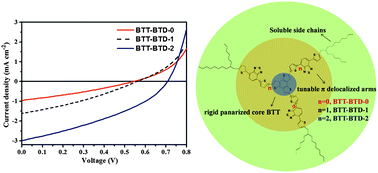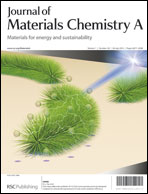Three structurally related conjugated molecules (BTT-BTD-0, BTT-BTD-1 and BTT-BTD-2) in star shape have been designed and synthesized as donor materials for small molecule based bulk heterojunction (BHJ) solar cells. The structural features of these molecules include a planarized benzo[1,2-b:3,4-b′:5,6-b″]trithiophene (BTT) with a C3h symmetry as the central core and three conjugated arms incorporating electron deficient benzo[2,1,3]thiadiazole (BTD) units, with arms being linked to the core via different number of thiophene connecting units (e.g., 0, 1, 2 corresponding to BTT-BTD-0, BTT-BTD-1 and BTT-BTD-2, respectively). Comparative analyses of optical and electronic properties indicate that the molecules bearing more thiophene units between the BTT core and the BTD arms possess higher-lying HOMO levels while their LUMO levels remain almost unchanged. The improvement of BHJ device performance, with [6,6]-phenyl-C61-butyric acid methyl ester (PC61BM) as the acceptor, is observed with increasing number of thiophene units between the BTT core and BTD arms, from BTT-BTD-0 to BTT-BTD-1 and BTT-BTD-2. The BTT-BTD-2:PC61BM based BHJ devices show the highest power conversion efficiency (PCE) of 0.74%, with an open-circuit voltage (Voc) of 0.69 V, a short-circuit current density (Jsc) of 2.93 mA cm−2, and a fill factor (FF) of 0.37 under 1 sun (100 mW cm−2) AM 1.5G simulated solar illumination. The PV performance of BTT-BTD-2 is further improved when [6,6]-phenyl-C71-butyric acid methyl ester (PC71BM) is used as the electron acceptor, yielding the best device performance with Jsc of 4.13 mA cm−2, Voc of 0.72 V, FF at 0.46 and PCE of 1.36%. The effect of the different number of thiophenes linking the BTT core and the conjugated BTD arms has been clearly demonstrated on regulating optical and electrochemical properties of the three molecules and their BHJ device performances.


 Please wait while we load your content...
Please wait while we load your content...